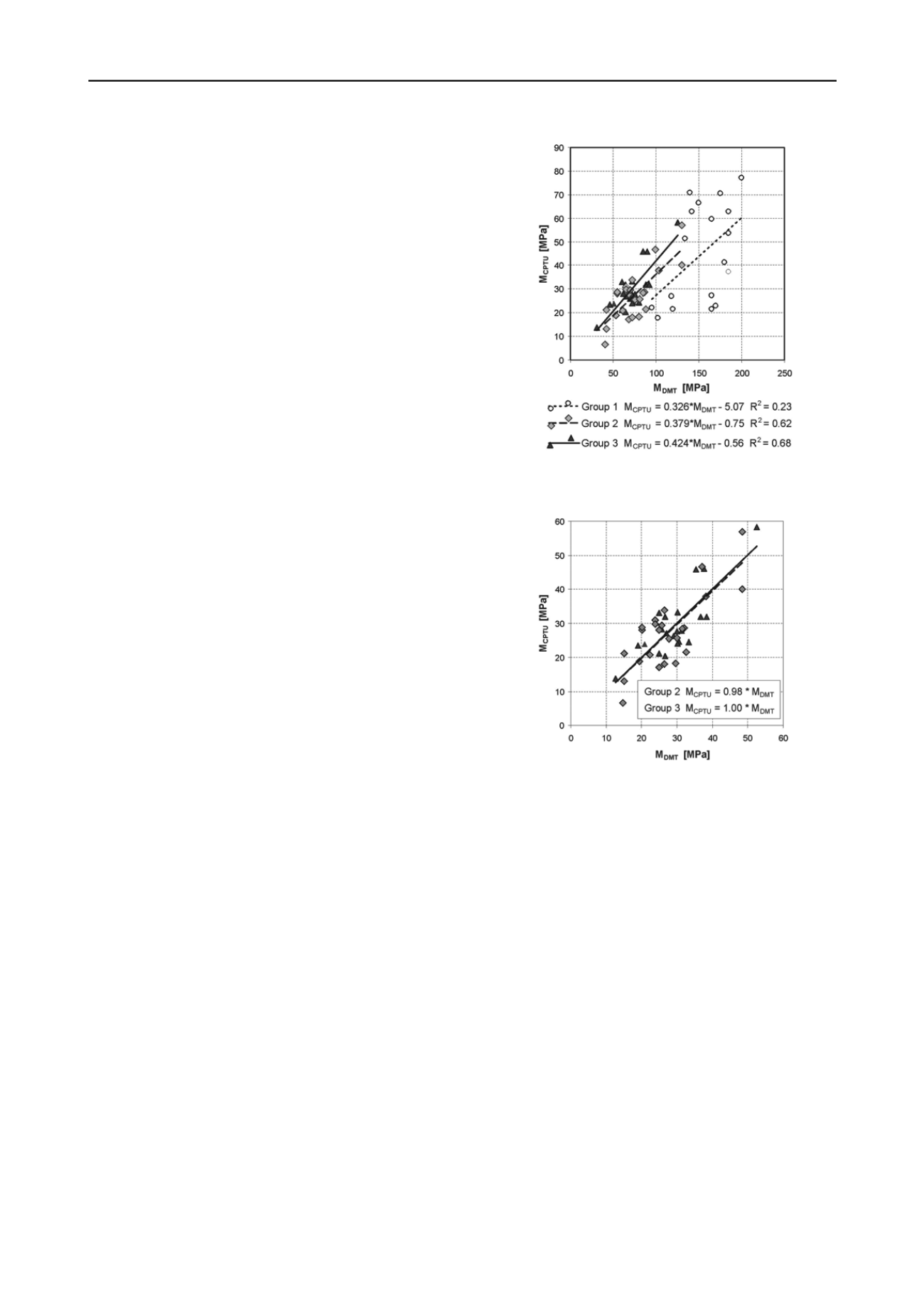
585
Technical Committee 102 /
Comité technique 102
4
THE RELATIONSHIP BETWEEN DEFORMATION
MODULI AND SHEAR MODULI FROM CPTU AND SDMT
4.1
Constrained deformation modulus – M
Concepts for the determination of modulus M from CPTU and
SDMT differ fundamentally. This results from the different
techniques of parameter measurements, which are introduced to
the relationship between the measured parameter and modulus
M. Another factor is connected with the different location of
CPTU and SDMT on the characteristics shear modulus
0
–
shear strain (Mayne 2000). In the case of CPTU modulus M is
determined from the relationship (Sanglerat 1972, Mayne 2000)
M
CPTU
=
1
(q
t
-
v0
)
(3)
In DMT the dilatometer modulus E
D
is the starting point for
the determination of modulus M
DMT
(Marchetti 1999)
M
DMT
= f (E
D
, K
D
, I
D
)
(4)
where K
D
– horizontal stress index according to Marchetti
(1999)
A modified original formula according to Marchetti for the
determination of R
M
for preconsolidated glacial tills was given
by Lechowicz et al. (2011).
4.2
Shear modulus G
0
A function which describes the relationship between modulus
G
0
or G from SDMT or SCPTU and variables which describe
parameters of the soil medium was given by Lee and Stokes
(1986), Jamiolkowski et al. (1995)
G
0
= f (
’
v0
, e
0
, OCR, S
r
, C, K, T)
(5)
where: (
’
v0
– geostatic effective vertical stress, e
0
– initial void
ratio, OCR – overconsolidation ratio, S
r
– degree of saturation,
C- grain characteristics, K – soil structure, T- temperature.
This relationship may be used to forecast values of modulus
G
0
directly on the basis of cone resistance Q
t
.
4.3
Analysis of results
4.3.1
Constrained moduli M
CPTU
, M
DMT
To calibrate the relationship between moduli M
CPTU
and M
DMT
individual moduli were determined from the following
formulas. For the CPTU test according to Mayne (2000) (eq. no.
3).
This formula was verified by oedometric tests. The analysis
showed that for the tested loams and clays the mean value of
coefficient
i
was close to 8.25.
Modulus M
CPTU
for non-cohesive soils was calculated from
dependencies supplied by Lunne et al. (1997) depending on
values q
c
and including the degree of preconsolidation in these
deposits.
Moduli M
DMT
were calculated prior to calibration from
original formulas proposed by Marchetti et al. (1999).
Figure 7. Relationship between constrained modulus M
0
CPTU
and M
0
DMT
.
Figure 8. Relationship between constrained modules M
0
CPTU
and M
DMT
after calibration.
For preconsolidated deposits the moduli determined by
SDMT are higher than those from CPTU (Fig. 7). Obtained
relationships fully confirm the opinion by Marchetti et al.
(1999) on this subject.
Calibration of both moduli in order to describe their changes
in the subsoil with changes in
v0
is presented in Figs. 8. It was
assumed in the calibration process that modulus M
CPTU
is the
reference point.
4.3.2
Shear moduli G
0
DMT
, G
0
CPTU
The determination of shear modulus from CPTU – G
0
CPTU
was
based on empirical dependencies
for non-cohesive soils (group 1) (after Hegazy, Mayne
1995)
V
s
= 12,02
q
t
0,319
f
s
-0,0466
(6)
G
0
=
V
s
2
(7)
for cohesive soils (groups 2 and 3) relationship
determined using multi linear regression
Group 2
G
0
= 41,44
q
t
+ 0,31
G
v0
+ OCR – 1,71
(8)


